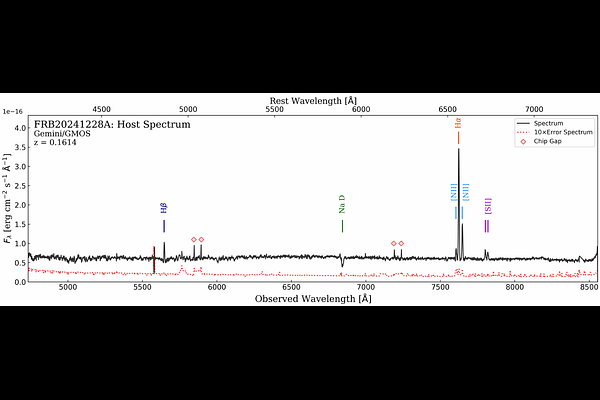Discovery and Localization of the Swift-Observed FRB 20241228A in a Star-forming Host Galaxy

Discovery and Localization of the Swift-Observed FRB 20241228A in a Star-forming Host Galaxy
Alice P. Curtin, Shion Andrew, Sunil Simha, Alice Cai, Kenzie Nimmo, Shami Chatterjee, Amanda M. Cook, Fengqiu Adam Dong, Yuxin Dong, Tarraneh Eftekhari, Wen-fai Fong, Emmanuel Fonseca, Jason W. T. Hessels, Ronniy C. Joseph, Victoria Kaspi, Calvin Leung, Robert Main, Kiyoshi W. Masui, Ryan Mckinven, Daniele Michilli, Mason Ng, Ayush Pandhi, Aaron B. Pearlman, Ziggy Pleunis, Mawson W. Sammons, Ketan R. Sand, Paul Scholz, Vishwangi Shah, Kaitlyn Shin, Aaron Tohuvavohu
AbstractOn 2024 December 28, CHIME/FRB detected the thus-far non-repeating FRB 20241228A with a real-time signal-to-noise ratio of $>50$. Approximately 112~s later, the X-ray Telescope onboard the Neil Gehrels Swift Observatory was on source, the fastest follow-up to-date of a non-repeating FRB (Tohuvavohu et al. in prep.). Using CHIME/FRB and two of the three CHIME/FRB Outriggers, we obtained a Very Long Baseline Interferometry localization for FRB 20241228A with a 1$\sigma$ confidence ellipse of 11$^{\prime\prime}$ by 0.2$^{\prime\prime}$. This represents the first published localization using both the CHIME-KKO and CHIME-GBO Outriggers. We associate FRB 20241228A with a star-forming galaxy at a redshift of $z = 0.1614\pm0.0002$. The persistent X-ray luminosity limit at this source's location and distance is $<1.2 \times 10^{43}$ erg s$^{-1}$ in the $0.3-10$ keV band, the most stringent limit of any non-repeating FRB to-date (Tohuvavohu et al. in prep.). The stellar mass ($\sim 2.6 \times 10^{10}\,M_{\odot}$) and star formation rate ($\sim 2.9\,M_{\odot}$~yr$^{-1}$) of the host galaxy of FRB 20241228A are consistent with the broader FRB host galaxy population. We measure significant scattering ($\sim$1ms) and scintillation ($\sim$20 kHz at 600 MHz) along the line of sight to this source, and suggest the scintillation screen is Galactic while the scattering screen is extragalactic. FRB 20241228A represents an exciting example of a new era in which we can harness VLBI-localizations and rapid high-energy follow-up to probe FRB progenitors.